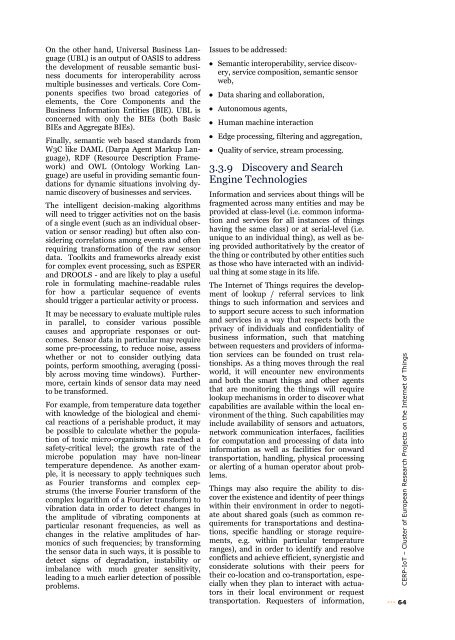Vision and Challenges for Realising the Internet of Things
Vision and Challenges for Realising the Internet of Things
Vision and Challenges for Realising the Internet of Things
Create successful ePaper yourself
Turn your PDF publications into a flip-book with our unique Google optimized e-Paper software.
On <strong>the</strong> o<strong>the</strong>r h<strong>and</strong>, Universal Business Language<br />
(UBL) is an output <strong>of</strong> OASIS to address<br />
<strong>the</strong> development <strong>of</strong> reusable semantic business<br />
documents <strong>for</strong> interoperability across<br />
multiple businesses <strong>and</strong> verticals. Core Components<br />
specifies two broad categories <strong>of</strong><br />
elements, <strong>the</strong> Core Components <strong>and</strong> <strong>the</strong><br />
Business In<strong>for</strong>mation Entities (BIE). UBL is<br />
concerned with only <strong>the</strong> BIEs (both Basic<br />
BIEs <strong>and</strong> Aggregate BIEs).<br />
Finally, semantic web based st<strong>and</strong>ards from<br />
W3C like DAML (Darpa Agent Markup Language),<br />
RDF (Resource Description Framework)<br />
<strong>and</strong> OWL (Ontology Working Language)<br />
are useful in providing semantic foundations<br />
<strong>for</strong> dynamic situations involving dynamic<br />
discovery <strong>of</strong> businesses <strong>and</strong> services.<br />
The intelligent decision-making algorithms<br />
will need to trigger activities not on <strong>the</strong> basis<br />
<strong>of</strong> a single event (such as an individual observation<br />
or sensor reading) but <strong>of</strong>ten also considering<br />
correlations among events <strong>and</strong> <strong>of</strong>ten<br />
requiring trans<strong>for</strong>mation <strong>of</strong> <strong>the</strong> raw sensor<br />
data. Toolkits <strong>and</strong> frameworks already exist<br />
<strong>for</strong> complex event processing, such as ESPER<br />
<strong>and</strong> DROOLS - <strong>and</strong> are likely to play a useful<br />
role in <strong>for</strong>mulating machine-readable rules<br />
<strong>for</strong> how a particular sequence <strong>of</strong> events<br />
should trigger a particular activity or process.<br />
It may be necessary to evaluate multiple rules<br />
in parallel, to consider various possible<br />
causes <strong>and</strong> appropriate responses or outcomes.<br />
Sensor data in particular may require<br />
some pre-processing, to reduce noise, assess<br />
whe<strong>the</strong>r or not to consider outlying data<br />
points, per<strong>for</strong>m smoothing, averaging (possibly<br />
across moving time windows). Fur<strong>the</strong>rmore,<br />
certain kinds <strong>of</strong> sensor data may need<br />
to be trans<strong>for</strong>med.<br />
For example, from temperature data toge<strong>the</strong>r<br />
with knowledge <strong>of</strong> <strong>the</strong> biological <strong>and</strong> chemical<br />
reactions <strong>of</strong> a perishable product, it may<br />
be possible to calculate whe<strong>the</strong>r <strong>the</strong> population<br />
<strong>of</strong> toxic micro-organisms has reached a<br />
safety-critical level; <strong>the</strong> growth rate <strong>of</strong> <strong>the</strong><br />
microbe population may have non-linear<br />
temperature dependence. As ano<strong>the</strong>r example,<br />
it is necessary to apply techniques such<br />
as Fourier trans<strong>for</strong>ms <strong>and</strong> complex cepstrums<br />
(<strong>the</strong> inverse Fourier trans<strong>for</strong>m <strong>of</strong> <strong>the</strong><br />
complex logarithm <strong>of</strong> a Fourier trans<strong>for</strong>m) to<br />
vibration data in order to detect changes in<br />
<strong>the</strong> amplitude <strong>of</strong> vibrating components at<br />
particular resonant frequencies, as well as<br />
changes in <strong>the</strong> relative amplitudes <strong>of</strong> harmonics<br />
<strong>of</strong> such frequencies; by trans<strong>for</strong>ming<br />
<strong>the</strong> sensor data in such ways, it is possible to<br />
detect signs <strong>of</strong> degradation, instability or<br />
imbalance with much greater sensitivity,<br />
leading to a much earlier detection <strong>of</strong> possible<br />
problems.<br />
Issues to be addressed:<br />
Semantic interoperability, service discovery,<br />
service composition, semantic sensor<br />
web,<br />
Data sharing <strong>and</strong> collaboration,<br />
Autonomous agents,<br />
Human machine interaction<br />
Edge processing, filtering <strong>and</strong> aggregation,<br />
Quality <strong>of</strong> service, stream processing.<br />
3.3.9 Discovery <strong>and</strong> Search<br />
Engine Technologies<br />
In<strong>for</strong>mation <strong>and</strong> services about things will be<br />
fragmented across many entities <strong>and</strong> may be<br />
provided at class-level (i.e. common in<strong>for</strong>mation<br />
<strong>and</strong> services <strong>for</strong> all instances <strong>of</strong> things<br />
having <strong>the</strong> same class) or at serial-level (i.e.<br />
unique to an individual thing), as well as being<br />
provided authoritatively by <strong>the</strong> creator <strong>of</strong><br />
<strong>the</strong> thing or contributed by o<strong>the</strong>r entities such<br />
as those who have interacted with an individual<br />
thing at some stage in its life.<br />
The <strong>Internet</strong> <strong>of</strong> <strong>Things</strong> requires <strong>the</strong> development<br />
<strong>of</strong> lookup / referral services to link<br />
things to such in<strong>for</strong>mation <strong>and</strong> services <strong>and</strong><br />
to support secure access to such in<strong>for</strong>mation<br />
<strong>and</strong> services in a way that respects both <strong>the</strong><br />
privacy <strong>of</strong> individuals <strong>and</strong> confidentiality <strong>of</strong><br />
business in<strong>for</strong>mation, such that matching<br />
between requesters <strong>and</strong> providers <strong>of</strong> in<strong>for</strong>mation<br />
services can be founded on trust relationships.<br />
As a thing moves through <strong>the</strong> real<br />
world, it will encounter new environments<br />
<strong>and</strong> both <strong>the</strong> smart things <strong>and</strong> o<strong>the</strong>r agents<br />
that are monitoring <strong>the</strong> things will require<br />
lookup mechanisms in order to discover what<br />
capabilities are available within <strong>the</strong> local environment<br />
<strong>of</strong> <strong>the</strong> thing. Such capabilities may<br />
include availability <strong>of</strong> sensors <strong>and</strong> actuators,<br />
network communication interfaces, facilities<br />
<strong>for</strong> computation <strong>and</strong> processing <strong>of</strong> data into<br />
in<strong>for</strong>mation as well as facilities <strong>for</strong> onward<br />
transportation, h<strong>and</strong>ling, physical processing<br />
or alerting <strong>of</strong> a human operator about problems.<br />
<strong>Things</strong> may also require <strong>the</strong> ability to discover<br />
<strong>the</strong> existence <strong>and</strong> identity <strong>of</strong> peer things<br />
within <strong>the</strong>ir environment in order to negotiate<br />
about shared goals (such as common requirements<br />
<strong>for</strong> transportations <strong>and</strong> destinations,<br />
specific h<strong>and</strong>ling or storage requirements,<br />
e.g. within particular temperature<br />
ranges), <strong>and</strong> in order to identify <strong>and</strong> resolve<br />
conflicts <strong>and</strong> achieve efficient, synergistic <strong>and</strong><br />
considerate solutions with <strong>the</strong>ir peers <strong>for</strong><br />
<strong>the</strong>ir co-location <strong>and</strong> co-transportation, especially<br />
when <strong>the</strong>y plan to interact with actuators<br />
in <strong>the</strong>ir local environment or request<br />
transportation. Requesters <strong>of</strong> in<strong>for</strong>mation,<br />
CERP-IoT – Cluster <strong>of</strong> European Research Projects on <strong>the</strong> <strong>Internet</strong> <strong>of</strong> <strong>Things</strong><br />
64
















